Are you planning a trip to Vietnam and intrigued by its unique blend of cultures? Let SIXT.VN guide you through the captivating history of Phat Diem Cathedral, a remarkable architectural marvel. Discover when it was built and the story behind its creation, blending Eastern and Western influences, and let SIXT.VN take care of all your transportation and accommodation needs for a seamless journey to Ninh Binh. Explore cultural landmarks and religious sites.
1. What is Phat Diem Cathedral and Why is it Significant?
Phat Diem Cathedral is a unique and historically significant Catholic cathedral complex located in Kim Son District, Ninh Binh Province, Vietnam. Its significance lies in its distinctive architectural style, which blends traditional Vietnamese pagoda design with Gothic and Romanesque elements. This fusion reflects the harmonious relationship between Catholicism and Vietnamese culture. The cathedral is often referred to as “the Catholic capital of Vietnam” due to its scale and historical importance.
Expanding on the significance:
- Architectural Fusion: The blending of Vietnamese and European architectural styles makes Phat Diem Cathedral an exceptional example of cultural syncretism. The use of Vietnamese temple and pagoda design principles in a Catholic cathedral is unlike anything else in the world, representing an integration of faith and local heritage.
- Historical Importance: Constructed over two decades in the late 19th century, the cathedral served as a vital center for the Catholic community during a period of French colonial rule and religious suppression. It stands as a testament to the perseverance and adaptation of Catholicism in Vietnam.
- Cultural Symbolism: The cathedral’s construction was led by Father Tran Luc (also known as “Uncle Six”), who sought to create a space that honored both Catholic faith and Vietnamese identity. Its design incorporates elements representing Vietnamese history, culture, and artistry.
- Local Pride: For the people of Ninh Binh and the surrounding region, Phat Diem Cathedral is a source of immense pride. It draws visitors from around the world, contributing to local tourism and providing a tangible link to their heritage.
- Artistic Achievement: The intricate stonework, woodwork, and overall design of the cathedral complex reflect a high level of craftsmanship and artistic skill. Local artisans played a crucial role in its construction, ensuring the incorporation of Vietnamese aesthetics.
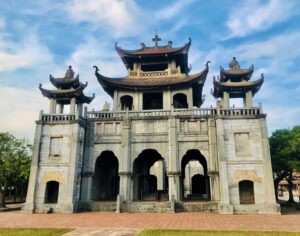 Phat Diem Cathedral more Buddhist than Christian
Phat Diem Cathedral more Buddhist than Christian
2. When Was Phat Diem Cathedral Built?
The construction of Phat Diem Cathedral spanned from 1875 to 1898, with its official consecration taking place in 1892. This 24-year undertaking reflects the immense effort and dedication required to create this architectural masterpiece.
Expanding on the construction timeline:
- Early Stages (1875-1883): The initial phase involved gathering resources, including stone and wood from distant regions. Father Tran Luc organized the transport of materials and oversaw the early construction of the complex’s foundations.
- Key Structures (1883-1891): The main cathedral, dedicated to Our Lady of the Rosary, was the primary focus during this period. The Phuong Dinh Bell Tower and other significant structures were also erected, showcasing the cathedral’s unique blend of architectural styles.
- Final Touches (1891-1898): The final years involved completing the chapels, grottoes, and landscaping. The official consecration in 1892 marked a significant milestone, although construction continued to refine and expand the complex.
- Father Tran Luc’s Vision: Father Tran Luc’s leadership was instrumental throughout the construction process. He not only designed the cathedral but also managed the logistics, fundraising, and labor needed to bring his vision to life.
- Local Involvement: The local community played a vital role in building the cathedral. Parishioners contributed their time, resources, and skills, demonstrating their commitment to the project and their faith.
3. Who Was Father Tran Luc (Uncle Six) and What Was His Role in the Cathedral’s Construction?
Father Tran Luc (1825-1899), affectionately known as “Uncle Six” by the local parishioners, was the visionary leader and driving force behind the construction of Phat Diem Cathedral. A local priest from Thanh Hoa province, Father Tran Luc, despite lacking formal architectural training, successfully designed and oversaw the entire project, turning his dream of a unique cathedral into reality.
Expanding on Father Tran Luc’s role:
- Visionary Design: Father Tran Luc conceived the idea of blending Vietnamese and European architectural styles to create a cathedral that would resonate with the local community and celebrate their cultural identity.
- Project Management: He managed all aspects of the construction process, from sourcing materials and raising funds to organizing labor and ensuring the project stayed on track.
- Community Leadership: Father Tran Luc inspired and mobilized the local Catholic community to contribute their time, resources, and skills to the construction effort.
- Negotiation and Diplomacy: He navigated complex political and social challenges, securing support from both the Vietnamese court and the French colonial authorities.
- Legacy: Father Tran Luc’s grave is located in the forecourt of the cathedral, a testament to his enduring legacy and his profound impact on the region.
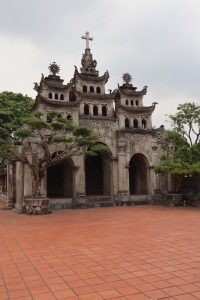 Rare photo of Father Pedro (Peter) Tran Luc
Rare photo of Father Pedro (Peter) Tran Luc
4. What are the Key Architectural Features of Phat Diem Cathedral?
Phat Diem Cathedral is renowned for its unique blend of Vietnamese and European architectural styles. Key features include its pagoda-like roofs, stone and wood construction, and intricate carvings, which reflect traditional Vietnamese temple design. The cathedral complex also includes a bell tower (Phuong Dinh), several chapels, and artificial grottoes, each contributing to its distinctive character.
Expanding on the architectural features:
- Vietnamese Pagoda Influence: The cathedral’s multi-tiered roofs, reminiscent of traditional Vietnamese pagodas, create a sense of harmony and integration with the surrounding landscape.
- Stone and Wood Construction: The primary building materials are locally sourced stone and ironwood, which contribute to the cathedral’s durability and aesthetic appeal.
- Intricate Carvings: The cathedral is adorned with detailed carvings of religious figures, floral motifs, and traditional Vietnamese symbols, showcasing the skill of local artisans.
- Phuong Dinh Bell Tower: This three-story structure, made of stone and wood, serves as a bell tower and a prominent landmark within the cathedral complex. Its design blends Vietnamese and European elements, further emphasizing the cathedral’s unique architectural fusion.
- Chapels and Grottoes: The complex includes several smaller chapels dedicated to different saints, each with its own distinct architectural style. The artificial grottoes provide serene spaces for reflection and prayer.
5. What Materials Were Used to Build Phat Diem Cathedral and Where Did They Come From?
The primary materials used in the construction of Phat Diem Cathedral were stone and wood. Stone was sourced from Thien Duong Mountain (approximately 30 km away) and Nhoi Mountain in Thanh Hoa province (approximately 60 km away). Wood was obtained from Nghe An, Thanh Hoa, and Son Tay provinces. These materials were transported by river using rafts and barges, a significant logistical feat at the time.
Expanding on the materials and their origins:
- Stone: The use of local limestone gives the cathedral a sense of permanence and connection to the surrounding landscape. The stone was carefully selected and transported to Phat Diem, where it was shaped and incorporated into the cathedral’s structure.
- Wood: Ironwood was chosen for its strength and durability, making it ideal for supporting the cathedral’s massive roofs and structures. The wood was sourced from distant provinces and transported by river, requiring careful planning and coordination.
- Local Sourcing: The reliance on local materials not only reduced costs but also ensured that the cathedral blended harmoniously with its environment. It also provided opportunities for local artisans and laborers to contribute to the project.
- Logistical Challenges: Transporting the stone and wood over long distances was a major undertaking, requiring the use of rafts, barges, and human labor. Father Tran Luc and his team overcame these challenges through careful planning and community involvement.
- Symbolic Significance: The use of local materials also symbolized the integration of Catholicism with Vietnamese culture and the commitment of the local community to the construction of the cathedral.
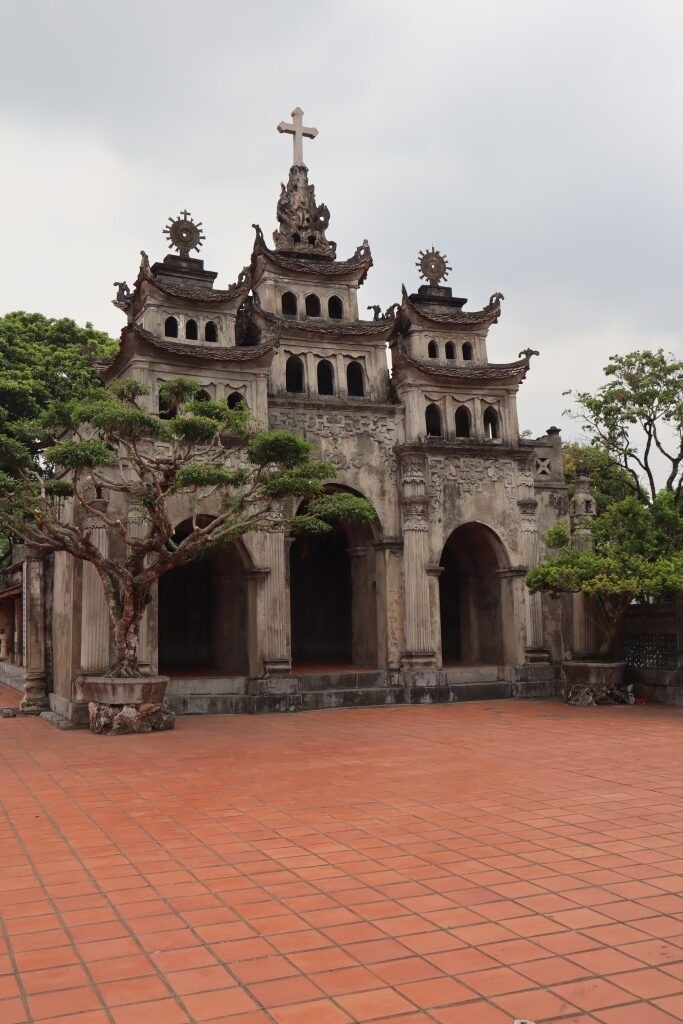 Sacred Heart Chapel at Phat Diem
Sacred Heart Chapel at Phat Diem
6. How Does Phat Diem Cathedral Blend Vietnamese and European Architectural Styles?
Phat Diem Cathedral uniquely blends Vietnamese and European architectural styles by incorporating traditional Vietnamese pagoda designs with Gothic and Romanesque elements. The pagoda-like roofs, stone and wood construction, and intricate carvings reflect Vietnamese temple design, while the overall structure and interior layout incorporate European architectural principles.
Expanding on the blend of architectural styles:
- Pagoda-Like Roofs: The cathedral’s multi-tiered roofs are its most distinctive feature, resembling those found on traditional Vietnamese pagodas. This design element creates a sense of harmony and integration with the surrounding landscape.
- Stone and Wood Construction: The use of local stone and ironwood is another example of Vietnamese influence, as these materials are commonly used in traditional Vietnamese architecture.
- Intricate Carvings: The cathedral’s intricate carvings of religious figures, floral motifs, and traditional Vietnamese symbols further emphasize its Vietnamese identity.
- Gothic and Romanesque Elements: The cathedral’s overall structure, including its arches, columns, and vaulted ceilings, reflects European Gothic and Romanesque architectural principles.
- Cultural Syncretism: The blending of these styles represents a deliberate attempt to create a space that honors both Catholic faith and Vietnamese culture, reflecting a spirit of cultural syncretism and integration.
7. What is the Phuong Dinh Bell Tower and Its Significance?
The Phuong Dinh Bell Tower, also known as the “Square House,” is a three-story structure within the Phat Diem Cathedral complex. Completed in 1899, it stands 25 meters high and is constructed from heavy stone and wood. The tower houses a large bell and features Vietnamese pagoda-style roofs and turrets adorned with statues of saints. It served as a watchtower during conflicts and is now a symbol of the cathedral’s resilience.
Expanding on the Phuong Dinh Bell Tower:
- Architectural Marvel: The Phuong Dinh Bell Tower is considered a masterpiece of the Phat Diem Cathedral complex, showcasing the skillful blending of Vietnamese and European architectural styles.
- Strategic Importance: The tower’s height and sturdy construction made it an ideal watchtower during conflicts, allowing defenders to monitor the surrounding area and provide early warnings of attack.
- Cultural Symbolism: The tower’s Vietnamese pagoda-style roofs and turrets adorned with statues of saints reflect the cathedral’s commitment to cultural integration and the harmonious blending of faith and local heritage.
- Graham Greene Connection: The tower is famously linked to author Graham Greene, who used it to observe the battle between French colonial forces and Viet-Minh resistance fighters in 1951.
- Enduring Legacy: The Phuong Dinh Bell Tower stands as a symbol of the cathedral’s resilience and its enduring legacy as a place of worship and cultural significance.
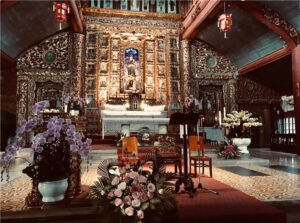 Phat Diem Cathedral Interior
Phat Diem Cathedral Interior
8. What are the Chapels and Grottoes Within the Phat Diem Cathedral Complex?
The Phat Diem Cathedral complex includes several smaller chapels and artificial grottoes, each with its own unique history and significance. The chapels, such as the Church of the Immaculate Heart (the “Stone Church”), Saint Roco’s Church, Saint Joseph’s Church, and Saint Peter’s Church, are dedicated to different saints and feature distinct architectural styles. The grottoes, including Burial Mountain, Mount Lourdes, and Skull Mountain, provide spaces for reflection and prayer.
Expanding on the chapels and grottoes:
- Church of the Immaculate Heart (Stone Church): Constructed entirely of local stone, this chapel is the oldest in the complex and is known for its simple yet elegant design.
- Saint Roco’s Church, Saint Joseph’s Church, and Saint Peter’s Church: These chapels, built with local stone and ironwood beams, are dedicated to different saints and feature intricate carvings and ornate fittings.
- Burial Mountain (Birthday Mountain): The oldest of the three grottoes, this artificial cave provides a serene space for reflection and prayer.
- Mount Lourdes: Originally named the Garden of Gethsemane, this grotto is dedicated to Our Lady of Lourdes and is a popular pilgrimage site.
- Skull Mountain: Originally called the cave of Bethlehem, this grotto features a statue of the Crucifixion and serves as a reminder of the sacrifice of Jesus Christ.
9. How Has Phat Diem Cathedral Survived Wars and Natural Disasters?
Over the past 130 years, Phat Diem Cathedral has faced numerous challenges, including wars and natural disasters. Its sturdy construction, using local stone and ironwood, has helped it withstand these challenges. Additionally, the local community has consistently rallied to repair and restore the cathedral, demonstrating their unwavering commitment to preserving this important cultural and religious landmark.
Expanding on the cathedral’s resilience:
- Sturdy Construction: The use of durable materials and traditional building techniques has enabled the cathedral to withstand the effects of wars and natural disasters.
- Community Support: The local community has consistently supported the cathedral, providing labor, resources, and expertise to repair and restore it after periods of conflict or natural disasters.
- Adaptive Reuse: In some cases, the cathedral has been adapted for different purposes during times of crisis, such as serving as a shelter for refugees or a hospital for the wounded.
- Symbolic Significance: The cathedral’s resilience has made it a symbol of hope and perseverance for the local community, representing their ability to overcome challenges and maintain their cultural identity.
- Ongoing Preservation Efforts: Today, efforts are underway to preserve and protect the cathedral for future generations, ensuring that its unique architectural and cultural heritage is maintained.
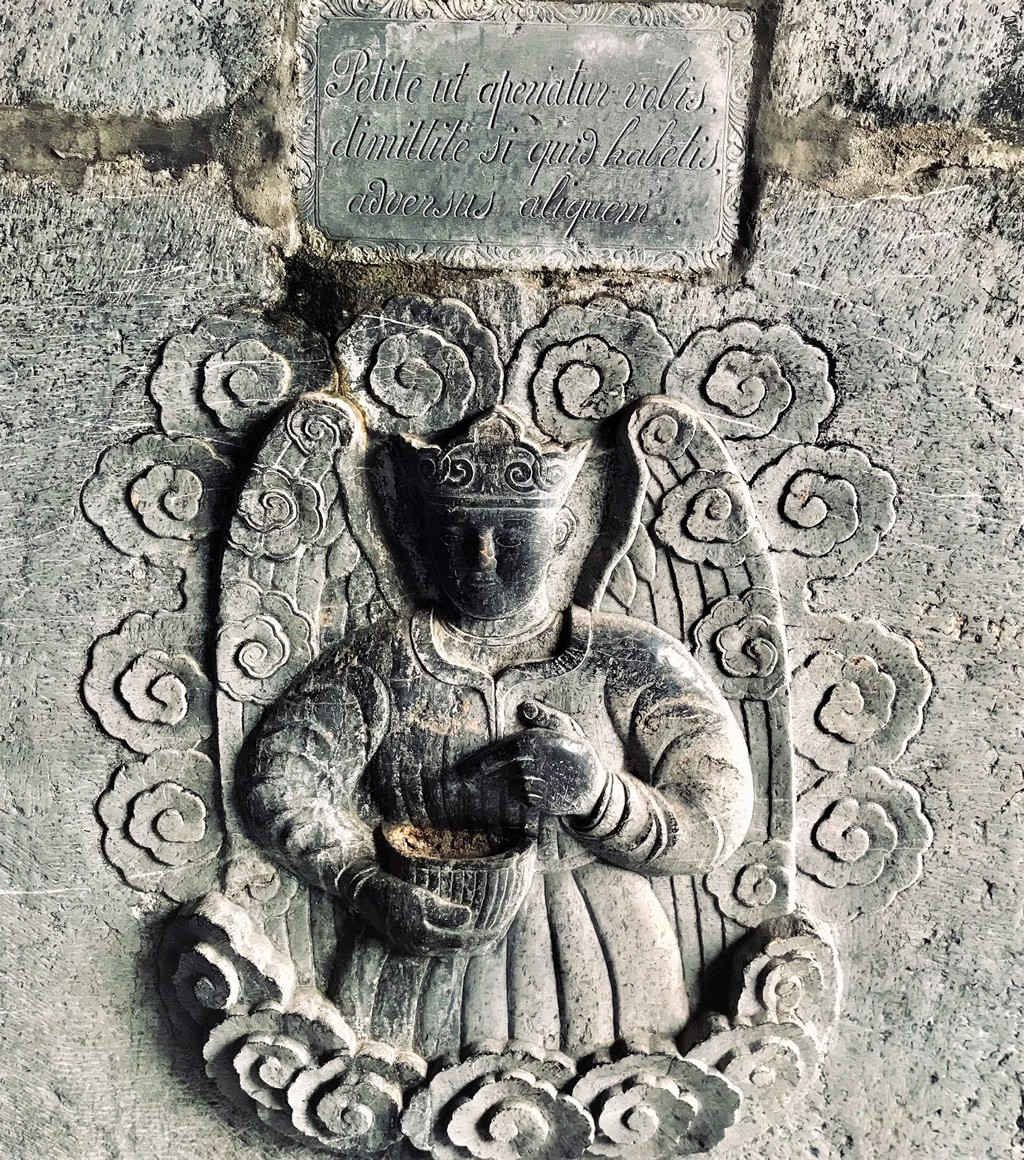 Stone Angel at Phat Diem
Stone Angel at Phat Diem
10. What Should Visitors Know Before Visiting Phat Diem Cathedral?
Visitors to Phat Diem Cathedral should dress modestly and respectfully, as it is a place of worship. Avoid loud noises and large gatherings that could disrupt the solemn atmosphere. Photography is permitted, but be mindful of local customs and traditions. It is recommended to wear comfortable shoes for walking around the large grounds and to bring accessories like hats, sunglasses, and umbrellas to protect against the weather. Note that the main chapels are generally not open to tourists, except for religious services.
Expanding on visitor advice:
- Dress Code: Dress modestly and respectfully, avoiding revealing clothing or attire that could be considered offensive.
- Behavior: Maintain a quiet and respectful demeanor, avoiding loud noises or disruptive behavior.
- Photography: Photography is generally permitted, but be mindful of local customs and traditions and avoid taking pictures during religious services.
- Footwear: Wear comfortable shoes, as the cathedral complex is large and requires a fair amount of walking.
- Weather Protection: Bring hats, sunglasses, and umbrellas to protect against the sun and rain, as the weather in Ninh Binh can be unpredictable.
- Chapel Access: Note that the main chapels are generally not open to tourists, except for religious services. Check the posted signs for mass times and other religious services.
11. How Can SIXT.VN Enhance Your Visit to Phat Diem Cathedral?
SIXT.VN offers comprehensive travel solutions to make your visit to Phat Diem Cathedral seamless and enjoyable. We provide airport transfer services from Hanoi, ensuring a comfortable and stress-free journey to Ninh Binh. Our hotel booking service offers a range of accommodations to suit your budget and preferences. Additionally, SIXT.VN can arrange guided tours to Phat Diem Cathedral and other attractions in Ninh Binh, providing you with valuable insights and local expertise.
Expanding on SIXT.VN’s services:
- Airport Transfers: SIXT.VN offers reliable and comfortable airport transfer services from Hanoi to Ninh Binh, ensuring a smooth transition from your flight to your destination.
- Hotel Booking: We provide a wide selection of hotels in Ninh Binh, ranging from budget-friendly options to luxury accommodations, catering to all types of travelers.
- Guided Tours: Our guided tours to Phat Diem Cathedral and other attractions in Ninh Binh offer a deeper understanding of the region’s history, culture, and architecture.
- Customized Itineraries: SIXT.VN can create customized itineraries tailored to your interests and preferences, ensuring that you experience the best of Ninh Binh.
- Local Support: Our local team is available to provide support and assistance throughout your trip, ensuring a hassle-free and memorable experience.
12. What is the Best Time of Year to Visit Phat Diem Cathedral?
The best time to visit Phat Diem Cathedral is during the dry season, which typically runs from November to April. During this period, the weather is generally pleasant with less rainfall, making it ideal for exploring the cathedral complex and the surrounding area. The shoulder seasons (September-October and April-May) can also be good times to visit, with fewer crowds and mild temperatures.
Expanding on the best time to visit:
- Dry Season (November to April): The dry season offers the most predictable weather, with sunny days and low humidity, making it ideal for outdoor activities and sightseeing.
- Shoulder Seasons (September-October and April-May): These months offer a balance of pleasant weather and fewer crowds, making them a good option for travelers seeking a more relaxed experience.
- Wet Season (May to September): The wet season can bring heavy rainfall and occasional typhoons, which may disrupt travel plans. However, the lush green landscapes can also be quite beautiful during this time.
- Festivals: Consider visiting during local festivals, such as the Phat Diem Cathedral Festival, to experience the region’s culture and traditions firsthand.
- Personal Preferences: Ultimately, the best time to visit depends on your personal preferences and priorities, whether you prefer sunny weather, fewer crowds, or cultural experiences.
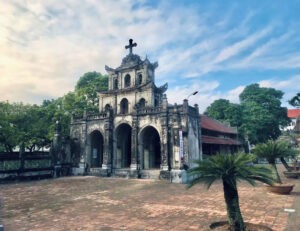 A corner of Phat Diem Cathedral
A corner of Phat Diem Cathedral
13. Are There Any Local Customs or Etiquette to Be Aware Of When Visiting?
When visiting Phat Diem Cathedral, it’s important to respect local customs and etiquette. Dress modestly, avoid loud noises, and be mindful of religious services. Ask for permission before taking photos of people, and be respectful of the sacred nature of the site. Learning a few basic Vietnamese phrases can also enhance your interactions with locals.
Expanding on local customs and etiquette:
- Dress Modestly: Dress modestly and respectfully, avoiding revealing clothing or attire that could be considered offensive.
- Be Quiet: Maintain a quiet and respectful demeanor, avoiding loud noises or disruptive behavior.
- Respect Religious Services: Be mindful of religious services and avoid entering the chapels during mass.
- Ask for Permission: Ask for permission before taking photos of people, especially monks or nuns.
- Be Respectful: Be respectful of the sacred nature of the site and avoid touching religious artifacts or defacing the buildings.
- Learn Basic Phrases: Learning a few basic Vietnamese phrases, such as “Xin chào” (hello) and “Cảm ơn” (thank you), can enhance your interactions with locals and show your respect for their culture.
- Tipping: Tipping is not customary in Vietnam, but it is appreciated for good service.
14. What Other Attractions are Near Phat Diem Cathedral?
Ninh Binh province, where Phat Diem Cathedral is located, is home to numerous other attractions worth visiting. These include:
- Trang An Landscape Complex: A UNESCO World Heritage site featuring stunning limestone karst formations, caves, and rivers.
- Tam Coc-Bich Dong: Known as “Halong Bay on Land,” this area offers boat tours through scenic waterways surrounded by rice paddies and towering cliffs.
- Mua Cave: Hike to the top of Mua Cave for panoramic views of the Tam Coc region.
- Bai Dinh Pagoda: One of the largest pagoda complexes in Southeast Asia, featuring impressive temples, statues, and gardens.
- Hoa Lu Ancient Capital: The former capital of Vietnam during the 10th and 11th centuries, featuring historic temples and ruins.
Expanding on nearby attractions:
- Trang An Landscape Complex: This UNESCO World Heritage site is a must-see destination, offering boat tours through stunning limestone karst formations, caves, and rivers.
- Tam Coc-Bich Dong: Known as “Halong Bay on Land,” this area offers boat tours through scenic waterways surrounded by rice paddies and towering cliffs.
- Mua Cave: Hike to the top of Mua Cave for panoramic views of the Tam Coc region, offering stunning photo opportunities.
- Bai Dinh Pagoda: One of the largest pagoda complexes in Southeast Asia, featuring impressive temples, statues, and gardens.
- Hoa Lu Ancient Capital: Explore the historic temples and ruins of Hoa Lu, the former capital of Vietnam during the 10th and 11th centuries.
- Van Long Nature Reserve: A peaceful wetland area known for its diverse birdlife and scenic landscapes.
- Cuc Phuong National Park: Vietnam’s oldest national park, offering hiking trails, wildlife viewing, and opportunities to learn about the region’s biodiversity.
15. How Can I Book Transportation and Accommodation for My Trip to Phat Diem Cathedral with SIXT.VN?
Booking transportation and accommodation for your trip to Phat Diem Cathedral with SIXT.VN is easy and convenient. Visit our website at SIXT.VN or contact our customer service team via Hotline/Whatsapp: +84 986 244 358. We offer a range of services, including airport transfers, hotel bookings, and guided tours, all designed to make your trip seamless and enjoyable.
Expanding on booking with SIXT.VN:
- Website: Visit our website at SIXT.VN to browse our services, view available options, and make secure online bookings.
- Customer Service: Contact our customer service team via Hotline/Whatsapp: +84 986 244 358 for personalized assistance and expert advice.
- Airport Transfers: Book your airport transfer in advance to ensure a smooth and stress-free journey from the airport to your hotel in Ninh Binh.
- Hotel Bookings: Choose from a wide selection of hotels in Ninh Binh to suit your budget and preferences, and book your accommodation with ease.
- Guided Tours: Arrange guided tours to Phat Diem Cathedral and other attractions in Ninh Binh, and let our experienced guides show you the best of the region.
- Customized Packages: Create customized travel packages tailored to your specific needs and interests, and let SIXT.VN take care of all the details.
Phat Diem Cathedral stands as a testament to the harmonious blend of Vietnamese and European cultures, a story etched in stone and wood. Now that you know more about its fascinating history, let SIXT.VN help you plan your visit to this architectural marvel. From airport transfers to hotel bookings and guided tours, we’ve got you covered. Contact SIXT.VN today at Hotline/Whatsapp: +84 986 244 358 or visit our website SIXT.VN and embark on an unforgettable journey to Ninh Binh.



